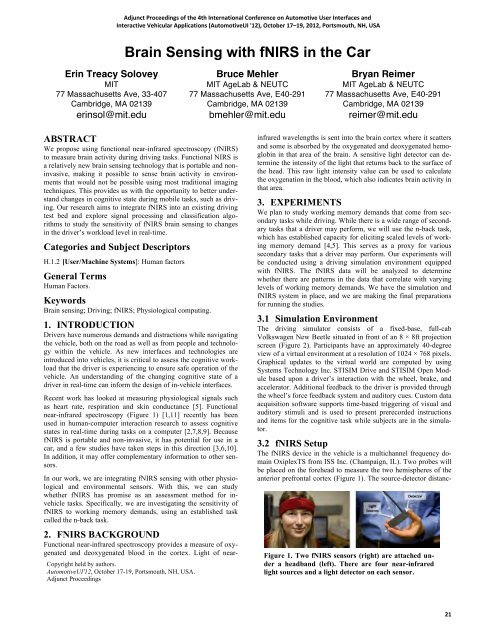12: Adjunct Proceedings - Automotive User Interfaces and ...
12: Adjunct Proceedings - Automotive User Interfaces and ...
12: Adjunct Proceedings - Automotive User Interfaces and ...
Create successful ePaper yourself
Turn your PDF publications into a flip-book with our unique Google optimized e-Paper software.
Erin Treacy Solovey<br />
MIT<br />
77 Massachusetts Ave, 33-407<br />
Cambridge, MA 02139<br />
erinsol@mit.edu<br />
Brain Sensing with fNIRS in the Car<br />
ABSTRACT<br />
We propose using functional near-infrared spectroscopy (fNIRS)<br />
to measure brain activity during driving tasks. Functional NIRS is<br />
a relatively new brain sensing technology that is portable <strong>and</strong> noninvasive,<br />
making it possible to sense brain activity in environments<br />
that would not be possible using most traditional imaging<br />
techniques. This provides us with the opportunity to better underst<strong>and</strong><br />
changes in cognitive state during mobile tasks, such as driving.<br />
Our research aims to integrate fNIRS into an existing driving<br />
test bed <strong>and</strong> explore signal processing <strong>and</strong> classification algorithms<br />
to study the sensitivity of fNIRS brain sensing to changes<br />
in the driver’s workload level in real-time.<br />
Categories <strong>and</strong> Subject Descriptors<br />
H.1.2 [<strong>User</strong>/Machine Systems]: Human factors<br />
General Terms<br />
Human Factors.<br />
<strong>Adjunct</strong> <strong>Proceedings</strong> of the 4th International Conference on <strong>Automotive</strong> <strong>User</strong> <strong>Interfaces</strong> <strong>and</strong><br />
Interactive Vehicular Applications (<strong>Automotive</strong>UI '<strong>12</strong>), October 17–19, 20<strong>12</strong>, Portsmouth, NH, USA<br />
Keywords<br />
Brain sensing; Driving; fNIRS; Physiological computing.<br />
1. INTRODUCTION<br />
Drivers have numerous dem<strong>and</strong>s <strong>and</strong> distractions while navigating<br />
the vehicle, both on the road as well as from people <strong>and</strong> technology<br />
within the vehicle. As new interfaces <strong>and</strong> technologies are<br />
introduced into vehicles, it is critical to assess the cognitive workload<br />
that the driver is experiencing to ensure safe operation of the<br />
vehicle. An underst<strong>and</strong>ing of the changing cognitive state of a<br />
driver in real-time can inform the design of in-vehicle interfaces.<br />
Recent work has looked at measuring physiological signals such<br />
as heart rate, respiration <strong>and</strong> skin conductance [5]. Functional<br />
near-infrared spectroscopy (Figure 1) [1,11] recently has been<br />
used in human-computer interaction research to assess cognitive<br />
states in real-time during tasks on a computer [2,7,8,9]. Because<br />
fNIRS is portable <strong>and</strong> non-invasive, it has potential for use in a<br />
car, <strong>and</strong> a few studies have taken steps in this direction [3,6,10].<br />
In addition, it may offer complementary information to other sensors.<br />
In our work, we are integrating fNIRS sensing with other physiological<br />
<strong>and</strong> environmental sensors. With this, we can study<br />
whether fNIRS has promise as an assessment method for invehicle<br />
tasks. Specifically, we are investigating the sensitivity of<br />
fNIRS to working memory dem<strong>and</strong>s, using an established task<br />
called the n-back task.<br />
2. FNIRS BACKGROUND<br />
Functional near-infrared spectroscopy provides a measure of oxygenated<br />
<strong>and</strong> deoxygenated blood in the cortex. Light of near-<br />
Copyright held by authors.<br />
<strong>Automotive</strong>UI'<strong>12</strong>, October 17-19, Portsmouth, NH, USA.<br />
<strong>Adjunct</strong> <strong>Proceedings</strong><br />
Bruce Mehler<br />
MIT AgeLab & NEUTC<br />
77 Massachusetts Ave, E40-291<br />
Cambridge, MA 02139<br />
bmehler@mit.edu<br />
Bryan Reimer<br />
MIT AgeLab & NEUTC<br />
77 Massachusetts Ave, E40-291<br />
Cambridge, MA 02139<br />
reimer@mit.edu<br />
infrared wavelengths is sent into the brain cortex where it scatters<br />
<strong>and</strong> some is absorbed by the oxygenated <strong>and</strong> deoxygenated hemoglobin<br />
in that area of the brain. A sensitive light detector can determine<br />
the intensity of the light that returns back to the surface of<br />
the head. This raw light intensity value can be used to calculate<br />
the oxygenation in the blood, which also indicates brain activity in<br />
that area.<br />
3. EXPERIMENTS<br />
We plan to study working memory dem<strong>and</strong>s that come from secondary<br />
tasks while driving. While there is a wide range of secondary<br />
tasks that a driver may perform, we will use the n-back task,<br />
which has established capacity for eliciting scaled levels of working<br />
memory dem<strong>and</strong> [4,5]. This serves as a proxy for various<br />
secondary tasks that a driver may perform. Our experiments will<br />
be conducted using a driving simulation environment equipped<br />
with fNIRS. The fNIRS data will be analyzed to determine<br />
whether there are patterns in the data that correlate with varying<br />
levels of working memory dem<strong>and</strong>s. We have the simulation <strong>and</strong><br />
fNIRS system in place, <strong>and</strong> we are making the final preparations<br />
for running the studies.<br />
3.1 Simulation Environment<br />
The driving simulator consists of a fixed-base, full-cab<br />
Volkswagen New Beetle situated in front of an 8 × 8ft projection<br />
screen (Figure 2). Participants have an approximately 40-degree<br />
view of a virtual environment at a resolution of 1024 × 768 pixels.<br />
Graphical updates to the virtual world are computed by using<br />
Systems Technology Inc. STISIM Drive <strong>and</strong> STISIM Open Module<br />
based upon a driver’s interaction with the wheel, brake, <strong>and</strong><br />
accelerator. Additional feedback to the driver is provided through<br />
the wheel’s force feedback system <strong>and</strong> auditory cues. Custom data<br />
acquisition software supports time-based triggering of visual <strong>and</strong><br />
auditory stimuli <strong>and</strong> is used to present prerecorded instructions<br />
<strong>and</strong> items for the cognitive task while subjects are in the simulator.<br />
3.2 fNIRS Setup<br />
The fNIRS device in the vehicle is a multichannel frequency domain<br />
OxiplexTS from ISS Inc. (Champaign, IL). Two probes will<br />
be placed on the forehead to measure the two hemispheres of the<br />
anterior prefrontal cortex (Figure 1). The source-detector distanc-<br />
Figure 1. Two fNIRS sensors (right) are attached under<br />
a headb<strong>and</strong> (left). There are four near-infrared<br />
light sources <strong>and</strong> a light detector on each sensor.<br />
21





